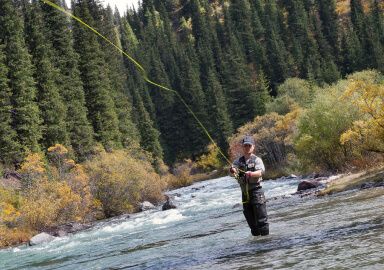Clown Knife Fish
The clown knife fish is an interesting addition to American fishing opportunities and adds a new dimension to freshwater fishing in parts of Florida.
View 3 listings
3
listings
–
price starting from
1
countries
–
to the nearest trip
Where and When?
The natural distribution of clown knife fish is Cambodia, Laos, Thailand and Vietnam, where they are an important food source. They are one of the most invasive fish species in the world and have spread, or been spread, to the Philippines, Malaysia and Sri Lanka as they are now extensively used in aquaculture for food and also the aquarium trade. In North America the first wild populations were reported in Florida in the 1990’s and, although they are still fairly limited in distribution there, it seems likely they will spread further. Attempts to eradicate them seem unlikely to succeed as they favour lakes, swamps and backwaters which form a complex network throughout much of Florida. Although the fish are naturally mostly nocturnal predators, they do feed throughout the day and early morning fishing is usually better than later in the day.
About Clown Knife Fish
The clown knife fish, also known as featherback (Chetala ornata), is an invasive species now found in limited areas of Florida. It does, however, provide some new and interesting fishing experiences and opportunities. It has a very distinctive laterally compressed, “knife shaped” body with a long anal fin on which adults have between 5 and 10 distinctive black “eye” spots. The narrow body is silvery grey with a large hump behind the head. It has large eyes but a fairly small mouth. Clown knife fish can attain one meter in length (3.3 ft.) and a maximum mass of 15 kilograms (33 lbs.) but most specimens are not nearly as large as this.
Females lay eggs on logs or similar substrates and the males fan the eggs to supply oxygen to them then also protect their young for limited periods after hatching. They are naturally nocturnal predators, feeding on small fish and invertebrates, but appear to engulf almost anything that moves and can fit into their mouths. Juveniles remain in shoals near structure but adults soon become solitary and roam around in search of food items. Featherbacks can “gulp” air and thus survive in poorly oxygenated waters where indigenous fish may perish.
How to Catch?
Due to its unusual shape, jumping skills and current small range in North America, the clown knife fish provides new fishing opportunities and experiences to anglers in limited areas in Florida. The best places in which to currently catch these fish are in lakes Osborne and Ida and by fishing from charter boats. The usual spinning tackle used to fish for bass is suitable for clown knife fish and the methods employed can also be similar. Clown knife fish generally seem to prefer live bait/food but do sometimes take dead bait or artificial lures.
The best bait usually depends on what natural foods are most abundant, but it is best to take guidance from charter boat operators who are well acquainted with the idiosyncrasies of this species. Casting live bait from a boat towards structure in the early morning is one of the best ways of achieving success with clown featherheads. While spreading alien fish species is generally a bad idea and illegal, if a species like this cannot be eradicated, then sport fishing is one way of obtaining some benefit from it.







